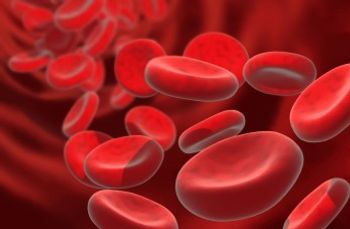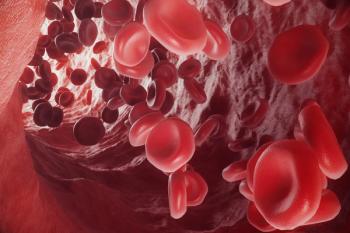
Olaparib/Radium-223 Combination Demonstrates Feasibility and Antitumor Activity in CRPC
The combination of olaparib and radium-223 improved rPFS in castration-resistant prostate cancer without prior docetaxel treatment or with fewer than 20 bone metastases.
Results from the COMRADE trial (NCT03317392) shared at the
The median rPFS was 8.9 months in the combination arm vs 4.7 months in the control arm (HR, 0.47; 90% CI, 0.34-0.65; P = .0013). The rPFS benefit was most pronounced in men without prior docetaxel treatment and those with 20 or fewer bone metastases.
“This was a positive study, resulting in a statistically significant improvement in the primary end point of rPFS in the intent-to-treat population,” lead author Rana R. McKay, MD, professor of medicine and urology, UC San Diego Health, in California, said during a presentation of the data.
COMRADE Study
The COMRADE study (NCT03317392) was a phase 1/2 study. In phase 1, the recommended phase 2 dose of olaparib of 200 mg twice daily was established, along with fixed dose radium-223 at 55 kBq/kg every 4 weeks for up to 6 doses.
In phase 2, patients were randomly assigned in a 1:1 ratio to the combination of olaparib plus radium-223 vs radium-223 alone. The primary end point was investigator-assessed rPFS. Stratification factors included prior docetaxel and extent of bone metastases. Crossover was permitted in the monotherapy arm. All patients required a baseline biopsy and progression biopsy was optional.
The study was powered at 88% to detect a 43% reduction in RPFs, corresponding to a hazard ratio of 0.57 with a 1-sided alpha of 0.1 with an enrollment of 120 patients. However, a total of 133 patients were enrolled in the phase 2 portion because the first 13 patients were mistakenly assigned to the combination arm due to an error in the electronic randomization algorithm, leading to nonrandomized enrollment. When this error was detected, the protocol was amended to expand enrollment to 133 patients, thereby ensuring that 120 patients would be properly enrolled.
At the time of this analysis, 57 patients discontinued treatment on the olaparib plus radium-223 arm, and of the patients allocated to radium-223 alone, 55 had discontinued treatment, of whom 23 crossed over to the combination.
The baseline characteristics were well balanced between the treatment arms with a median age of 69 years (range, 63-77) in the combination arm and 71 years (range, 66-76) in the monotherapy arm. The majority of patients were White, with about one-third of patients having an ECOG performance status of 0.
Across both arms, at least 46% of patients had 20 or more bone metastases on bone scan at baseline, and the majority of patients received a prior androgen receptor pathway inhibitor (96.7% vs 94.9%) and prior docetaxel (52.5% vs 50.8%). Additionally, the majority of patients were on a concurrent bone protecting agent (88.5% vs 91.5%), as required by the study.
In the prespecified subset analysis by prior docetaxel use, the greatest effect was observed in patients not having received prior docetaxel, with a median rPFS of 13.7 months in the combination arm vs 5.7 months in the monotherapy arm (HR, 0.24; 90% CI, 0.15-0.40). Further, in the prespecified analysis by extent of bone metastases, the greatest effect was observed in patients with 20 or fewer bone metastases on bone scan, with a median rPFS of 13.4 months vs 4.2 months, respectively (HR, 0.21; 90% CI, 0.13-0.33).
PSA response in the intent-to-treat population was also measured and showed a confirmed PSA50 response in 14.8% of patients and a 39.3% decline of any PSA in the combination arm vs a confirmed PSA50 in 15.3% patients and a decline of any PSA of 35.6% in the monotherapy arm.
Confirmed alkaline phosphatase responses were observed in 49.2% of patients in the combination arm compared with 50.8% in the radium-223 arm
Regarding secondary time-to-event end points, McKay and colleagues observed a numerically longer time to first symptomatic skeletal event in the combination arm vs the monotherapy arm, with a 1-year cumulative rate of 12.7% vs 22.9%, respectively.
“We did not observe differences in time to PSA progression, time to alkaline phosphatase progression, time to initiation of subsequent treatment, and overall survival. Interestingly, the median overall survival was 20 months in the combination arm vs 21 months in the monotherapy arm.
“This may [have been a result of] the fact that 23 patients crossed over to the combination arm,” McKay said. Additionally, 72% of patients went on to receive any subsequent therapy, of whom, 17 received chemotherapy, 14 received 177Lu-PSMA-617, and 5 entered a clinical trial.
Regarding toxicity, grade 3 or higher treatment-related adverse events were observed in 56% of patients in the combination arm and 33% of patients in the radium-223 arm.
“The main driver behind this difference was increased rate of lymphocytopenia [31.0%], which was largely managed with observation,” McKay said. Rates of anemia were slightly higher in the combination arm at 22.0% compared with 16.3% in the monotherapy arm.
In the combination arm, olaparib discontinuation due to toxicity occurred in 23.7% of patients and radium-223 discontinuation due to toxicity occurred in 11.9% of patients. In the radium-223 monotherapy arm, discontinuation due to toxicity occurred in 5.4% of patients.
In the ctDNA cohort, 18.9% of patients in the combination arm vs 26.5% of patients in the monotherapy arm were HRR positive.
When looking at HRR gene status, the rPFS benefit of the combination arm was most pronounced in patients without an HRR alteration (HR, 0.49; 90% CI, 0.34-0.71), which was statistically significant. “With only 23 patients in the HRR-positive group, it’s difficult to draw conclusions… but confirmatory tissue analyses are currently underway,” McKay said.
The prognostic significance of ctDNA tumor fraction in the overall population and between treatment arms was determined at cycle 1, day 1, and showed that the presence of ctDNA was associated with shorter rPFS in the overall population. The benefit of combination therapy was observed across both the ctDNA negative and positive groups.
Similarly, the prognostic significance of ctDNA tumor fraction at cycle 2 day 1 was also determined, and the data showed that the presence of ctDNA was associated with a shorter rPFS in the overall population. The benefit of combination therapy was observed across both the ctDNA negative and positive groups.
“The combination of olaparib with radium-223 demonstrated feasibility, safety, and antitumor activity in patients with metastatic castration-resistant prostate cancer with bone metastases,” McKay concluded.
Reference
McKay RR, Xie W, Ajmera A, et al. A multicenter, randomized, phase 2, investigator-initiated ETCTN trial of olaparib + radium-223 vs. radium-223 in men with castration-resistant prostate cancer (CRPC) with bone metastases (BM) (COMRADE): Initial efficacy and biomarker analysis. J Clin Oncol. 2025;43(suppl 17):5007. doi:10.1200/JCO.2025.43.16_suppl.5007
Newsletter
Stay up to date on recent advances in the multidisciplinary approach to cancer.


















































































